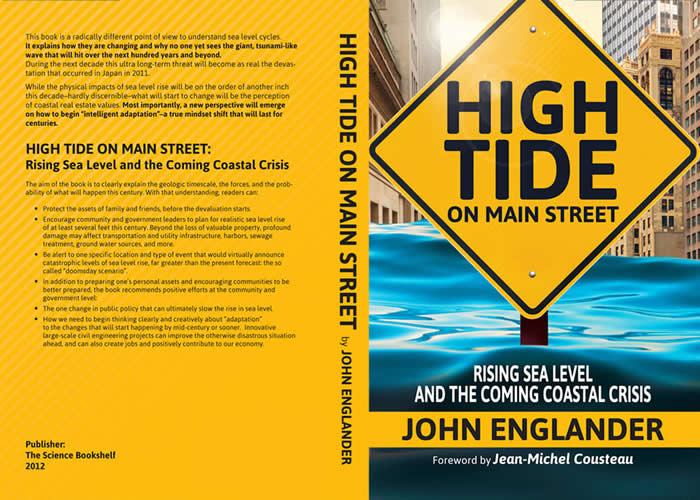Adaptation to Sea Level Rise Should Begin Today

Q: How did you get interested in the issue of sea level rise?
JE: My whole career has been involved with ocean studies of one sort or another. I started in college studying ancient sea levels; I just thought it was really cool that ancient sea levels moved up 300 to 400 feet with ice ages. (That's a lot. A tide moves up or down 3 to 4 feet.) I started doing that 40 years ago, but I never thought that that would change in my lifetime.
In 2004 I was asked to run a group called International Sea Keepers Society, and I took some of the members to Greenland and to show them the melting ice sheets. When you see these glaciers melting and you talk to people who have been there five generations and have never seen anything like this, it just makes it very real. You just realize that the planet is changing. It's slow but inexorable.
We're all concerned about where we live, our communities, our countries. If you can explain to someone that sea level is going to rise dozens of feet, eventually hundreds of feet, the shoreline is going to move inland. That's a fact that isn't easy to ignore or say isn't important.
Q: Why is sea level rise an issue that businesses should be taking seriously today?
JE: Sea level has been stable for centuries. And the fact that it's now beginning to rise is an epic change. It's a new era and there are a lot of implications. Eight inches of sea level rise will affect the water table in Florida. We're going to have problems with drinking water in the next 20 to 30 years. It affects everyone in business because it affects the design of ports and buildings on coasts. If the ports weren't designed for high enough sea level, we may have ports that don't function. This is going to be a slow, steady change that will unfold over decades. The good news is that we can plan for it and we need to start planning now. As the sea level rises and the shoreline moves over the coming decades, it's going to be very disruptive, but we have time to begin adapting.
Q: In “High Tide on Main Street,” you talk about intelligent adaptation. What do you mean by that?
JE: There are five parts to this. The first is to see the big picture and recognize where things are headed. If you realize that at some point sea level will be three feet and eventually six feet higher, you'll plan accordingly, so that your new building is sited, you will allow for that.
The second is seeing that the range of projections should not stop us from acting. If the range of projects is one to three feet of sea level rise this century, then let's prepare for that. Let's not use the uncertainty as a reason not to act.
The third point is that every place is different. One prescription won't fit all because the rate of sea level rise depends on the geology and topography of the area. Los Angeles, for example, has had four inches of sea level rise in the last century, while New York has had 14 inches and New Orleans has had 46 inches. At the same time, you have to look at geology. Manhattan is granite, so as Mayor Bloomberg announced, the plan to build some sea walls will work because it's not a beachfront island. It actually rises up quite sharply out of the water. Miami, on the other hand, is very low and porous limestone so a sea wall won't keep the water out; it will just come up behind the wall through the rock. So what works for the Netherlands won't necessarily work for Florida.
The fourth point is that we can't expect unlimited government funding for recovery. It's one thing for the federal government to help a town that is destroyed by a tornado. But as sea level rises and puts all coastal property under water, it won't be an isolated incident and the water is not going to go down again. We can't even rebuild there. The property is going to be destroyed. So we need to start thinking about a policy of what can the nation afford to reimburse people for? There's not enough money in the world to pay every coastal property that will be at risk from sea level rise. It's just not possible.
The fifth point is that once it becomes more widely known that sea level is going to rise slowly, at some point the vulnerable properties near the coast will be devalued. And that's a new concept because we don't currently amortize property. We amortize buildings, we depreciate cars, but raw land is kept on the balance sheet at its purchase price because we consider it permanent. That's going to change. So the coastal property values will probably be adjusted in the coming decades. That's on the horizon.
Q: Change is hard. What will it look like for local communities who are dealing with this?
JE: It's going to be a tough transition, but those who look ahead and ask those questions will probably have a better sense of what's coming. And it is happening in many communities today.
In New South Wales Australia, they decided two years ago that the deed of any new property built on the coast would acknowledge that it was vulnerable to sea level rise this century. They're now getting pushback from property owners who are saying "That's hurting my property price." In the Netherlands, where they have been recovering land for a thousand years, they planned for massive storms but that was before they understood what's happening with sea level. Now they have to re-think their plans. For them it's national security: One-third of their country is below sea level. In New Jersey there's a debate going on as we speak that because of Sandy the flood zone map should be adjusted to account for bigger storms and sea level rise. And some property owners are fighting back saying, "No, that will increase my construction cost to re-build."
This is going to go on for a while. But where people see higher insurance costs, higher building costs, we will begin to adapt. We need to decide what a good government policy is for subsidizing coastal flood insurance or what the federal government will reimburse from a storm versus predictable sea level rise. Those are really important discussions that businesses need to have and elected members of our government need to have.
Sea level rise is not an opinion, and you can resist it and rebuild your house on the beach if you want, or you can fret about it and say, "What could we have done to stop this?" All I want to do is to figure out what do we do next.
Related
About the Author

NAEM Staff
The National Association for Environmental, Health and Safety, and Sustainability (EHS&S) Management (NAEM) empowers corporate leaders to advance environmental stewardship, create safe and healthy workplaces and promote global sustainability. As the
leading business community for EHS&S decision-makers, we provide engaging forums, a curated network, peer benchmarking, research insights and tools for solving today’s corporate EHS&S management challenges. Visit us online at naem.org.

